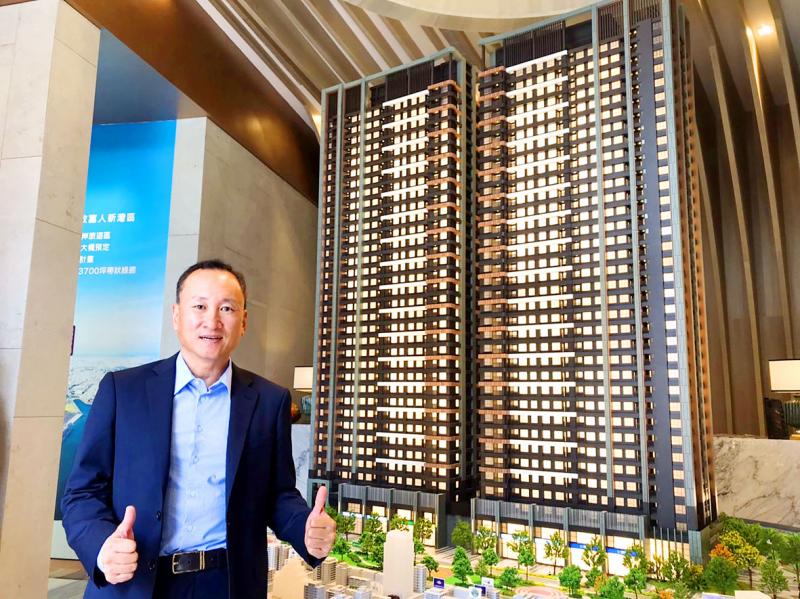Presale and new housing projects in Taipei totaled NT$189.8 billion (US$6.43 billion) in the first seven months of this year, with urban regeneration projects accounting for 65 percent, as they increasingly become the main source of properties due to a shortage of new land, the Chinese-language My Housing Monthly reported yesterday.
Renewal projects based on old and dilapidated houses in Taipei reached NT$124.2 billion from January to last month, supplying a record 65 percent to the city’s new housing volume as idle lots of land are hard to find, the magazine said.
“‘Knock down and rebuild’ has become the main focus of developers still eyeing the Taipei market,” My Housing Monthly research manager Ho Shih-chang (何世昌) said.

Photo: Hsu Yi-ping, Taipei Times
In the past, time-consuming regeneration projects were a secondary concern, but they have gained importance over the past few years after policymakers provided regulatory support and banks are eager to supply funding.
Renewal projects last year accounted for 43 percent of presale and new housing, up from 33 percent in 2018, the magazine said.
The trend is not surprising as 70 percent of Taipei’s buildings are at least 30 years old — much higher than the national average of 47 percent — while the city has 30,000 buildings that are older than 50, government data showed.
The scarcity of land leaves developers interested in Taipei with no choice but to turn old and unsafe buildings into sources of new housing projects, Ho added.
Regeneration projects underpin new housing in the Xinyi (信義), Songshan (松山), Zhongshan (中山), Daan (大安), Wanhua (萬華), Nangang (南港), Neihu (內湖) and Shihlin (士林) districts, the magazine reported.
The projects account for 100 percent of new housing in Songshan and 95 percent in Nangang, indicating that the trend is gaining momentum in both central and second-tier locations, it said.
“Developers and builders need to jump on the ‘knock down and rebuild’ wagon whether they like it or not,” Ho said, adding that regeneration projects are likely to constitute more than 50 percent of new housing for years to come.

Intel Corp chief executive officer Lip-Bu Tan (陳立武) is expected to meet with Taiwanese suppliers next month in conjunction with the opening of the Computex Taipei trade show, supply chain sources said on Monday. The visit, the first for Tan to Taiwan since assuming his new post last month, would be aimed at enhancing Intel’s ties with suppliers in Taiwan as he attempts to help turn around the struggling US chipmaker, the sources said. Tan is to hold a banquet to celebrate Intel’s 40-year presence in Taiwan before Computex opens on May 20 and invite dozens of Taiwanese suppliers to exchange views

Application-specific integrated circuit designer Faraday Technology Corp (智原) yesterday said that although revenue this quarter would decline 30 percent from last quarter, it retained its full-year forecast of revenue growth of 100 percent. The company attributed the quarterly drop to a slowdown in customers’ production of chips using Faraday’s advanced packaging technology. The company is still confident about its revenue growth this year, given its strong “design-win” — or the projects it won to help customers design their chips, Faraday president Steve Wang (王國雍) told an online earnings conference. “The design-win this year is better than we expected. We believe we will win

Chizuko Kimura has become the first female sushi chef in the world to win a Michelin star, fulfilling a promise she made to her dying husband to continue his legacy. The 54-year-old Japanese chef regained the Michelin star her late husband, Shunei Kimura, won three years ago for their Sushi Shunei restaurant in Paris. For Shunei Kimura, the star was a dream come true. However, the joy was short-lived. He died from cancer just three months later in June 2022. He was 65. The following year, the restaurant in the heart of Montmartre lost its star rating. Chizuko Kimura insisted that the new star is still down

While China’s leaders use their economic and political might to fight US President Donald Trump’s trade war “to the end,” its army of social media soldiers are embarking on a more humorous campaign online. Trump’s tariff blitz has seen Washington and Beijing impose eye-watering duties on imports from the other, fanning a standoff between the economic superpowers that has sparked global recession fears and sent markets into a tailspin. Trump says his policy is a response to years of being “ripped off” by other countries and aims to bring manufacturing to the US, forcing companies to employ US workers. However, China’s online warriors